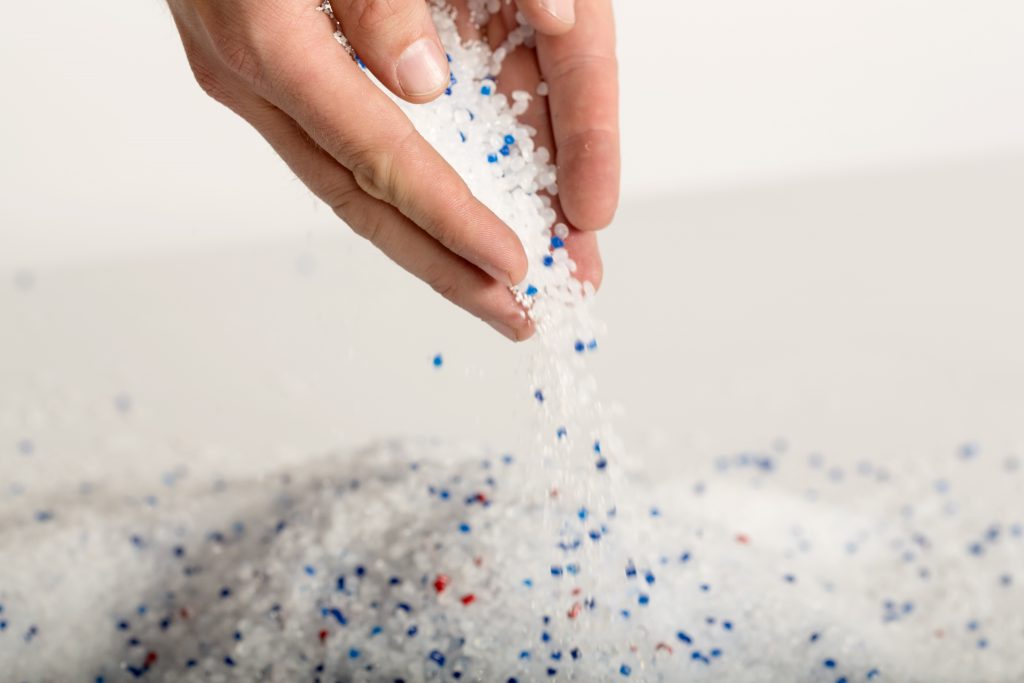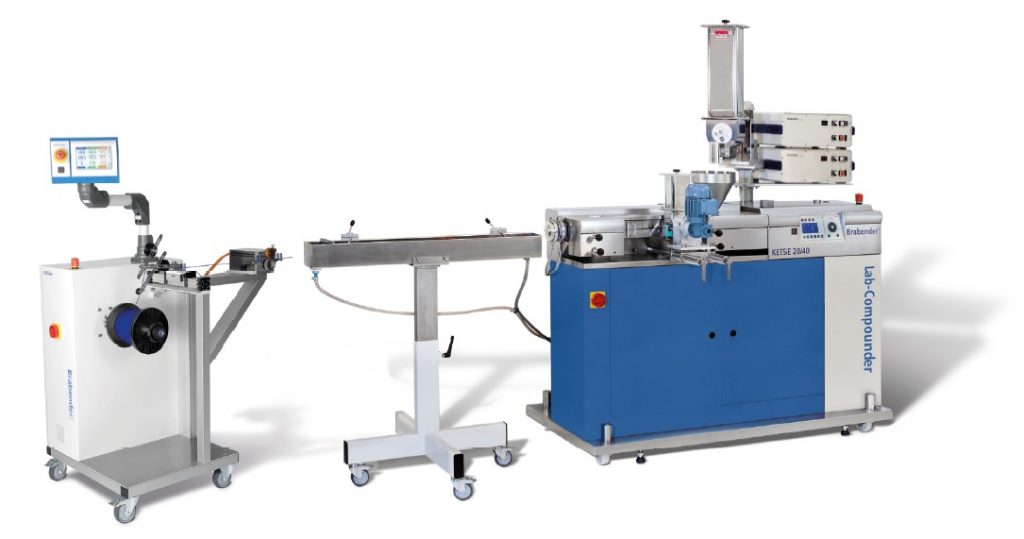One of the current priorities in the further evolution of additive manufacturing processes such as 3D printing is the “translation” of tried-and-tested polymer materials such as those used in injection molding to the “3D sector”. High-performance, precise winders which provide these filaments at a high, reproducible quality level and which are tailored to the special requirements of what are often smaller development laboratories play a role that continues to be underestimated. Brabender® GmbH & Co. KG from Duisburg, Germany presents one such new product.
This is a guest post by Dipl.-Ing. Jane Schwarz, Brabender® GmbH & Co. KG, Duisburg.
In the current 3D printing materials market, developers require laboratory production lines which are able to live up to the requirements of a particularly broad and multi-faceted group of users. Highly flexible yet affordable systems are needed, which are ideally also highly modular. At the same time, they should also meet the requirements of smaller research institutes which only require small filament batches of a highly specialized material — such as for medicine, for which 3D printing offers massive opportunities, as is well known.

The Brabender Winder: Economical and highly flexible
As a result, Brabender® GmbH & Co. KG, Duisburg, a recognized technological leader in the field of small to medium-sized extrusion installations for polymer development and processing at the laboratory scale, recently expanded its portfolio with a new component which is extremely important for the development of materials for 3D printing: The Branbender Winder.
A well-thought out, highly versatile winder, the new Brabender Winder helps to provide affordable filaments (among other things) made of thermoplastic polymers. It is a haul-off and winding device for universal use, which makes it the optimal interface between laboratory extruders and 3D printers. Its key advantages are the compatibility with typical laboratory throughput rates (due to lower winding speeds) and its modular design. Hence, Brabender’s newly developed machine closes the gap between small-scale extrusion for very small amounts below 200 g and a full-grown production system. This means users can now finally also produce first-rate filaments for R&D purposes using small material quantities typical for laboratory installations.

Advantages of the Brabender Winder at a glance:
- The quality of the extruded profiles, round strands, and filaments can be correlated directly and above all promptly with the extrusion process.
- Compact solution, low space requirement.
- Flexibility thanks to modular design: A large number of possible spool types, device can be retrofitted by the customer himself if necessary.
- No interruption of extrusion process when changing out the spool.
- Completes and rounds off all Brabender extrusion lines: All components from the * extruder to the winder are optimally tailored to each other.
- In Brabender extrusion installations: Complete software integration, control via familiar software interface (WinExt)
- Winder can also be installed downstream of third-party extruders.
Materials for 3D printing require specialists
One very important aspect of material winding which is often underestimated is the tension with which the newly created filament exiting the extruder die is transferred. In a twin-screw extruder, for example, all components of what is to become the filament, i.e. the plastic granules and various solid and liquid additives, are intensively mixed and plasticized.
In the Brabender Winder, the task of picking up the extruded plastic strand from the extruder is the duty of the haul-off unit. Its haul-off speed needs to be very closely coordinated with the output rate of the extruder; if it is too high, the filament may break or be stretched – which not only negatively impacts the filament diameter, but can also change the mechanical properties of the cured material. Furthermore, the tension can also influence the future restoring properties of the filament, which play an important role in the later unwinding and transportation process in the 3D printer.
To counteract this, it may be extremely helpful to cool the extrudate (i.e. the newly created plastic strand exiting the extruder) sufficiently; it is less susceptible to stretching processes when in a cooled state. Hence, it is ideally passed through an appropriately sized water bath with an adaptive blow-off device for removing the water on the surface.
Despite this, it is essential to not only ensure that the appropriate amount of force is exerted when hauling off the extrudate, but also that the forces are as uniform as possible.
The traction, winding speed, and the traversing unit of the the Brabender Winder are monitored constantly and in a mutually dependent manner. Furthermore, a great deal of effort is also made in the new Brabender Winder to reduce fluctuations in the diameter of the filament.

Precise, consistent 3D printer filament
Above all, Brabender’s special expertise really shows in the extremely precise print results, particularly in the case of smaller filament diameters.
In detail, the Brabender Winder makes possible the reproducible and at the same time economical provision of filaments with diameters of 0.5 to approx. four millimeters. The haul-off speeds can be between 0.2 to around 20 meters per minute.
Naturally, the Brabender Winder is also configured to fit a wide range of spools, which, among other things, may of course have varying spool core and flange diameters, as well as widths. Of course, all spools can be switched out extremely quickly and easily. This means that the extrusion process does not need to be interrupted when a switch is necessary. This also contributes to ensuring a constant filament quality.

Conclusion
The Brabender Winder presents itself as a universal and at the same time precise and highly economical workhorse which is ideal for integration into laboratory installations for the provision of extremely high-quality filaments for 3D printing – both for material developers with an industrial background as well as smaller research institutes at universities and universities of applied sciences.
In principle, there is practically no limit on the combination options with other units from Brabender’s extrusion line range as well as those of third-party suppliers – even filaments for pharmaceutical hot melt extrusion (HME) and the manufacture of material compounds for medical products are possible application scenarios.
Even in what may appear to be an inconspicuous role, the Brabender Winder will contribute to raising the bar for additive manufacturing technologies in the plastics sector.
Learn more about Brabender equipment here.
The Brabender Winder technical specifications
| Mounting hole of spool | 16 – 305 mm (from 60 mm with rim) |
| Spool core diameter | 60 – 310 mm |
| Flange diameter | max. 400 mm |
| Spool width | max. 200 mm |
| Spool weight | max. 15 kg gross |
| Filament diameter | 0.5 – 4 mm |
| Haul-off speed | 0.2 – 20 m/min |
| Dimensions | 705 x 1,600 x 1,200 mm |
| Weight | approx. 120 kg |
| Power supply | 3 x 400 V + N + PE, 50/60 Hz, 16 A |
For more of the latest additive manufacturing news releases subscribe to the 3D Printing Industry newsletter, like us on Facebook and follow us on Twitter.
Sign up to 3D printing jobs for new opportunities in this field.
Featured image shows the Brabender filament winding process. Photo via Brabender



